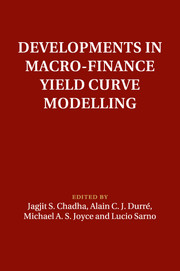Book contents
- Frontmatter
- Contents
- List of figures
- List of tables
- List of contributors
- Foreword
- Preface
- 1 Editors' introductory chapter and overview
- Part I Keynote addresses
- Part II New techniques
- Part III Policy
- Part IV Estimating inflation risk
- 13 Inflation compensation and inflation risk premia in the euro area term structure of interest rates
- 14 The predictive content of the yield curve for inflation
- 15 Inflation risk preminum and the term structure of macroeconmic announcements in the euro area and the United States
- Part V Default risk
- Index
13 - Inflation compensation and inflation risk premia in the euro area term structure of interest rates
from Part IV - Estimating inflation risk
Published online by Cambridge University Press: 05 February 2014
- Frontmatter
- Contents
- List of figures
- List of tables
- List of contributors
- Foreword
- Preface
- 1 Editors' introductory chapter and overview
- Part I Keynote addresses
- Part II New techniques
- Part III Policy
- Part IV Estimating inflation risk
- 13 Inflation compensation and inflation risk premia in the euro area term structure of interest rates
- 14 The predictive content of the yield curve for inflation
- 15 Inflation risk preminum and the term structure of macroeconmic announcements in the euro area and the United States
- Part V Default risk
- Index
Summary
13.1 Introduction
The term structure of interest rates is a fundamental source of information for monetary policymakers, especially for real yields, inflation expectations and risk premia. In particular, the yield spread between nominal and inflation-linked bonds, commonly referred to as the break-even inflation rate (BEIR), has become a key indicator of inflation expectations. Most major economies have issued inflation-linked debt in recent years, and detailed references to BEIRs in central bank publications and speeches (e.g. Bernanke, 2007; Trichet, 2005), research on the anchoring of inflation expectations (e.g. Gürkaynak, Levin and Swanson, 2010) and market commentary (e.g. Wall Street Journal, 2010) are increasingly common.
Monitoring developments in inflation expectations is crucial for a monetary policy oriented towards achieving price stability. Although BEIRs are available at different horizons and in real time, they are not a direct measure of inflation expectations. They reflect the overall inflation compensation that investors request to hold nominal bonds, comprising both the expected level of inflation and a premium to compensate for inflation risks. Decomposing BEIRs into inflation expectations and inflation risk premia is therefore crucial for research and policy purposes.
This chapter focuses on the decomposition of BEIRs into their inflation expectations and inlation risk premium components in the euro area, and discusses the challenges posed by the financial crisis for the correct interpretation of the spread between the two types of yield in the euro area sovereign bond market.
- Type
- Chapter
- Information
- Developments in Macro-Finance Yield Curve Modelling , pp. 361 - 389Publisher: Cambridge University PressPrint publication year: 2014

